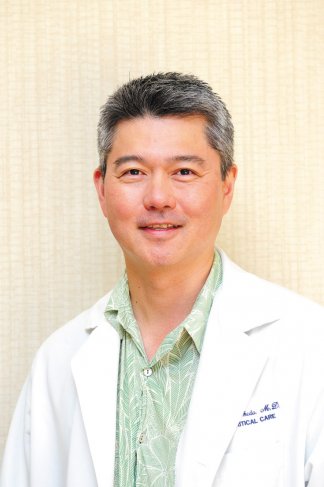Inpatient Respiratory Care
Dr. Reid Ikeda
Medical director of respiratory care services at The Queen’s Medical Center
Where did you receive your schooling and training?
I went to Punahou School, Yale University and Northwestern University Medical School in Chicago. I then did an internship, residency and chief medical residency at UC-San Diego. After that, I did a pulmonary and critical care medicine fellowship, also at UC-San Diego.
How long have you been in practice?
I finished my fellowship 12 years ago, and I have worked at Queen’s since then.
What got you interested in the field of respiratory care?
UC-San Diego has a strong pulmonary program, and many of my mentors were in the pulmonary division.
What does respiratory care in the hospital involve?
Respiratory therapy is primarily an inpatient discipline, although there also are some home-care services which involve respiratory care. Many patients in the hospital will at some point require respiratory care. They are assessed by respiratory care therapists, who are licensed professionals who make recommendations about how to treat their respiratory problems at the bedside. Some of the more common interventions include lung-inflation measures, respiratory-secretion clearance, delivery of oxygen and bronchodilator agents, and in the intensive care unit more advanced techniques such as non-invasive positive pressure ventilation and mechanical ventilation.
Who tends to need respiratory help?
Patients who have previously diagnosed pulmonary conditions such as asthma, chronic obstructive pulmonary disease, lung cancer and pulmonary fibrosis often are assessed and treated by respiratory therapists. Other patients without pre-existing conditions who are admitted with respiratory infections such as pneumonia, influenza and tuberculosis also require respiratory assistance. Some patients undergo surgery and require more respiratory assistance following the procedure.
Are people who go under for surgery able to naturally breathe on their own, or do they need a mechanical breathing apparatus?
It depends on pre-existing medical conditions of the patient and the type of procedure involved. Whether they require mechanical ventilation is determined by the anesthesiologist and the surgeon.
You helped Queen’s earn national quality respiratory care recognition honors six years in a row. What constitutes quality respiratory care?
This distinction was awarded by American Association for Respiratory Care, and 15 percent of U.S. hospitals have applied for and received this recognition. Some of the things that have helped us qualify for this distinction include staffing licensed respiratory therapists 24 hours a day, developing evidence-based respiratory care protocols that we have trained our respiratory care professionals to use to assess and treat patients, and having a designated medical director.
When someone has chronic lung conditions, are they generally waiting for a transplant or are they basically subject to respiratory care for their entire life?
Many patients with chronic lung problems do require long-term care from a pulmonologist, and some of them who are not expected to improve and who meet criteria are referred for a lung transplant evaluation. However, with increasing recognition and advances in medicine, some common diseases can be treated more effectively. A good example of this is obstructive sleep apnea. Home-care companies can deliver a continuous positive airway pressure or CPAP machine, and patients can be taught how to use it while they sleep.
Do you work with people who have sleep apnea?
Sleep apnea is a very common condition in Hawaii that is generally treated by pulmonologists and sleep-medicine specialists.
What causes sleep apnea?
Not all patients are overweight, but obesity increases the risk of obstructive sleep apnea. A simplified explanation is that when these patients sleep, their upper airway tends to collapse and air does not flow into the lungs easily, if at all. This is often manifested by snoring, choking and decreased oxygen levels during sleep, which can contribute to high blood pressure and place strain on the heart.
Anything else you’d like to mention about respiratory care?
Most patients understand what physicians, nurses and pharmacists do, but they are not always familiar with what a respiratory therapist does. These folks are licensed professionals who undergo an additional two years of training in a special program to learn how to assess and treat respiratory care problems. They assist with airway management, draw arterial blood gases, adjust ventilators, and perform lung inflation and secretion-management techniques to help patients get better faster.
What are arterial blood gases?
Blood is drawn usually from an artery in the wrist and sampled to see how much oxygen and carbon dioxide are in the circulation. We can make triage and treatment decisions, and adjust the ventilator in response to these levels.
Are those levels indicative of how well a person’s lungs are working?
The levels are indicative of oxygenation and ventilation, which are primarily dependent on the lungs.
For more information, call 691-7142.






